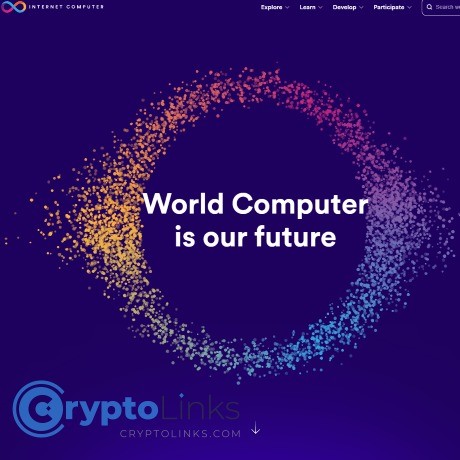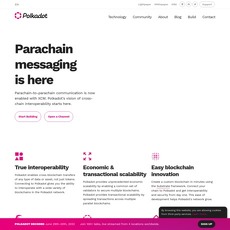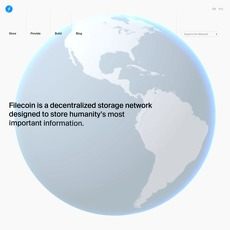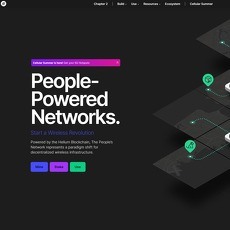Internet Computer (ICP) Review
Internet Computer (ICP)
internetcomputer.org
Internet Computer (ICP) Review Guide: Cutting Through the Hype and Confusion
Ever wondered why some crypto projects grab the spotlight while others fade into the background? Or maybe you’ve stumbled on something called Internet Computer (ICP) and found yourself lost in a tangle of bold claims and cryptic tech lingo? If so, you’re not alone. Trying to make sense of ICP can honestly feel like you need a tech degree just to start!
What’s So Hard About Understanding ICP?
Let’s be real—most people feel a little lost when first hearing about ICP. The crypto world is already overflowing with complicated tech, but ICP seems to take it to another level. From blockchain jargon to heated Twitter debates, it’s tough figuring out what’s actually real or why ICP keeps popping up in big crypto headlines.
- Technical terms everywhere: Canisters, NNS, brain-inspired governance—wait, what?
- Big promises: “Run the whole internet on a blockchain!” (Sounds wild because it is.)
- Opinions overload: With everyone from researchers to Reddit fans weighing in, it’s hard to know who’s telling the truth.
My Promise: Real Answers, Without the Hype
I’m here to keep things simple, honest, and grounded in real facts. My goal? Answer the questions you actually care about—like what ICP truly does, if it’s safe, how it really stacks up against other big-name projects, and more. No unnecessary buzzwords or sales fluff. Just the kind of straightforward guidance I wish I’d found back when I started out!
What You’ll Get in This Guide
Here’s a sneak peek at what’s coming your way:
- ICP’s background—why it exists and what it’s really trying to change
- The actual tech, explained in everyday language (promise: zero cryptononsense!)
- Pros and cons from the view of regular users and investors
- Real comparisons to other top Web 3.0 projects (because it’s not the only one aiming big)
- A super practical FAQ with exactly what real people want to know about ICP
Whether you’re just crypto-curious or looking to take your knowledge further, you’ll find the straight talk, examples, and practical info you need right here. Ready to finally get what all the ICP buzz is about—and see if it’s worth your time?
Remind yourself: behind all the hype, ICP is trying to shake up how the internet itself works. Intrigued? Hang tight—next, I’ll break down exactly what ICP is, what makes it unique, and why people are calling it the next big thing (or just another pipe dream).
What Is Internet Computer (ICP)?
So, you keep seeing Internet Computer (ICP) pop up on crypto forums, Twitter (X), and maybe even in big headlines. But what’s this actually all about—and why are so many people excited (or totally confused) by it?
The Vision: A Decentralized Internet
Okay, let’s get real. ICP’s mission? To shake up how the whole internet works. Instead of building websites and web apps on the “old” internet (which relies on big companies like Amazon Web Services, Google Cloud, etc.), ICP imagines everything running directly on its decentralized network. That’s right—even social networks and business tools could, in theory, exist without a single corporate server farm pulling the strings.
Think about it:
- No single company controlling your favorite app.
- No data brokers selling your info behind your back.
- No centralized point that hackers can easily target.
It’s basically the dream that Web 3.0 keeps promising—except ICP is trying to actually build it, not just talk about it.
How ICP Works (Without the Jargon)
I know, you’ve probably heard words like “canisters” and “smart contracts” tossed around like confetti. Here’s what matters:
- Canisters: These are ICP’s version of supercharged smart contracts. Instead of just managing simple actions (like swapping coins), canisters can actually run entire websites and apps straight on the blockchain. Imagine uploading your Instagram clone to the blockchain. That’s the vibe.
- Decentralization at the core: Apps built with ICP live on a blockchain instead of some data center. Updates, data access, even code are shared and managed by the network itself—no secret server hiding in the background.
- Speed and Scale: Here’s the kicker: ICP claims it can do this as fast as the old-school web. According to the DFINITY Foundation (the team behind ICP), websites on their network can serve billions of users, with transaction speeds that compete with “normal” websites—not just blockchains.
"Web3 isn't just a buzzword. It's about rewriting the rules of the internet—making it fairer, faster, and about the people, not the middlemen."
If you’re already picturing Reddit or WhatsApp running entirely outside Big Tech’s grasp—you’re getting what ICP is aiming for.
Why ICP Stands Out From the Crowd
Here’s the truth: most blockchains today are built for digital money (Bitcoin) or programmable transactions (Ethereum). ICP? It sets its sights higher. It wants to rebuild the entire online world, from back-end code to user-facing websites. That’s why it’s both bold and, honestly, a bit controversial. Skeptics ask, “Can it really deliver?” Fans point at early projects already running (like OpenChat—a decentralized rival to WhatsApp) and say, “See? It’s happening!”
It goes beyond coins and tokens; ICP is about giving us a new kind of web. Some early studies, like the technical deep dives by Messari, highlight both the vision and real technical challenges facing ICP. But love it or hate it, no one can accuse ICP of thinking small.
When you hear the phrase "Internet Computer," think “The cloud, but owned by everyone—not just an elite few.”
But how does all this connect to the bigger Web 3.0 revolution, and why should you care if you’re just a regular internet user (not a tech giant)? Well, that’s where things get even more interesting. Ready to see why people say ICP could rewrite the rules for Web 3.0? Let’s keep going…
Why Does ICP Matter For Web 3.0?
The world is hungry for something better than what Silicon Valley serves up. Imagine an internet with no gatekeepers, where you actually own your data and interact freely—no arbitrary bans, no monetizing your attention without your say. That’s what’s on the table when people talk about ICP and its place in Web 3.0. Let’s see why it’s such a hot topic.
Decentralization & User Empowerment
The way things work now, a handful of giants—Amazon, Google, Meta—call the shots. ICP wants to shake all that up by cutting out these middlemen. On this new network, it’s the users who control their data, content, and even the apps themselves. Real ownership, not just empty marketing.
- No more corporate lock-ins: If you create something cool on ICP, it lives on-chain, not inside a private server farm.
- Your identity, your rules: Want to move your data from one social network to another? You can, because ICP’s Network Nervous System lets you decide, not a trillion-dollar boardroom.
“Web 3.0 is about giving people power again.” That idea hits home, especially as more folks wake up to the downsides of today’s internet.
Bridging Web 2.0 and Web 3.0
Here’s the kicker: ICP isn’t just another blockchain that can only run oddball crypto games or endless JPEGs. It’s designed to host real, familiar apps—stuff we all use—totally decentralized, but still quick and user-friendly.
- OpenChat: A decentralized competitor to WhatsApp or Telegram—all of it runs directly on ICP, not rented cloud servers.
- Distrikt: Think of it as the Web 3.0 version of LinkedIn, letting users control their professional profile without a central authority snooping.
These aren’t just experiments; they have thousands of users already. Research by Messari shows a growing trend of social and productivity dApps shifting from traditional clouds to on-chain models. People want an internet that respects them.
Connections to Other Top Projects
ICP isn’t building in a vacuum. It’s part of a wider push by projects like Polkadot, which links up blockchains, and Filecoin, which stores data in a decentralized way. Each one is attacking Web 3.0 challenges from a different angle:
- Polkadot: Builds bridges between different blockchains, making ICP apps accessible across networks.
- Filecoin: Provides decentralized storage for ICP-powered sites and apps, keeping everything safe and censorship-resistant.
Here’s what’s wild—thanks to these connections, ICP could eventually power not just one “new internet,” but a patchwork of services all working together. It’s the kind of ecosystem where actual user choice is possible.
“The Internet Computer’s magic isn’t in just being decentralized—it’s connecting, scaling, and empowering us all at once.”
Curious about how all this high-level Web 3.0 talk actually works under the hood? Ever wondered what makes ICP possible from a tech point of view—and if it can really keep up with the internet as we know it? Keep reading, because the next section will break it all down with zero nonsense. Want to know if ICP is really as fast and scalable as it claims? Let’s open the box and find out.
How Does ICP Technology Actually Work?
Alright, let’s pull back the curtain and see what’s really under the hood of Internet Computer (ICP). There’s a lot of talk about "breaking the internet," but how does this stuff actually function in the real world? Here’s the lowdown, jargon-free, exactly as I wish someone had explained it to me.
Blockchain, Canisters, and “Internet Computers”
Most blockchains are like highways built for sending tokens or running basic smart contracts. ICP tells them, “Hold my beer.” Its core technology? Canisters.
- What’s a canister? Think of it as a supercharged container that holds both code and data—basically, self-contained apps that live directly on the blockchain. Imagine a full Twitter-like app running inside the blockchain itself. It’s wild, but totally real.
- How do they work? These canisters communicate with users, other canisters, and even external services. They auto-scale as more people use them. For comparison, Ethereum smart contracts feel like a bicycle next to ICP's sports car—perfect for simple stuff, but canisters handle much deeper, more complex app logic.
Projects like OpenChat and DSCVR are already proving that you can run social platforms, not just token vaults, straight on-chain with ICP’s tech. It’s not just PowerPoint slides—it’s alive and working. I’ve seen these projects in action, and they’re changing what people expect from the blockchain.
The Network Nervous System (NNS)
This name sounds like sci-fi, and honestly, it kinda is. ICP’s Network Nervous System (NNS) is basically the brain of the whole project. But instead of a boardroom of suits running things, it’s run by the community of ICP token holders.
- How’s that possible? NNS lets anyone with ICP tokens propose changes—like network upgrades or bug fixes. The more tokens you stake, the more voting power you have.
- Does that even work? According to DFINITY (the project behind ICP), major decisions have already been voted on via NNS, such as increasing subnet capacity or updating security protocols. It’s not some hands-off rulebook; it’s a real, evolving democracy. There’s even a public dashboard where you can watch every proposal and vote get counted.
"The ultimate promise of blockchain isn’t just removing middlemen, but giving actual control back to the crowd. ICP’s NNS takes that to a new level."
Is It Really Scalable and Fast?
This is where bold claims meet the real world. ICP often says, “We’re as fast as the traditional internet—maybe faster.” But is that hype, or the real deal?
- Tested in the wild: Early benchmarks (like those published by DFINITY’s blog) have shown ICP can serve web content with response times well below one second, even at scale. Real ICP dApps, like Internet Identity, load almost instantly—something most blockchains could only dream of.
- Auto-scaling: ICP uses subnets (smaller blockchains that run in parallel) to break up the work. When usage spikes, it just spins up more subnets—no bottle-necked, monster-monolithic blockchain here.
There are always bumps on the road. Some devs on GitHub have flagged issues with scaling during heavy usage, but compared to the constant gas wars on Ethereum, ICP shows signs of being seriously different. Many researchers, like those at the University of Zurich, say its architecture opens up "unprecedented Web 3.0 scaling potential."
But is ICP’s tech all it’s cracked up to be—and could that translate to real-world value (or risks) for you? Keep reading, because the next section tackles those tough, honest questions nearly everyone is asking. You might be surprised at what’s just around the corner…
Common Questions about ICP (And Honest Answers)
What is Internet Computer (ICP) used for?
People ask me this all the time, and it’s honestly one of the coolest parts about ICP. It’s not just another crypto token; it’s trying to become the backbone for a completely new internet. With ICP, developers can build and host websites, apps, games, social networks, and more—all directly on the blockchain. No need for Amazon or Google servers.
A few examples? There’s OpenChat (think of a decentralized WhatsApp), DSCVR (a community platform similar to Reddit), and even DeFi tools, all running on ICP’s network.
“We’re not just hosting code on a blockchain. We’re hosting real web experiences,” said an ICP dev on Reddit—and that’s the magic people are chasing right now.
How is ICP different from Ethereum or other blockchains?
This one trips up a lot of folks. While Ethereum is famous for smart contracts, ICP goes a step further. Ethereum is super strong for finance and simple dApps, but ICP aims to run entire, interactive websites and heavy-duty apps natively on-chain—something Ethereum just can’t do at scale (yet).
- Ethereum: Great for DeFi, NFTs, simple logic, but limited in web speed and user experience.
- ICP: Designed for hosting next-gen web apps (think Twitter or TikTok, but decentralized).
ICP uses "canisters" (advanced smart contracts) that scale and update easily. That’s tough on Ethereum without third-party help, and usually gets too expensive for mainstream websites.
Is ICP a good investment?
Let’s get real—ICP’s price history is a rollercoaster. After its wild debut, the token price crashed hard, and a lot of people felt burned. But recently, some dev activity and launches hint at new life. If you’re thinking about investing, remember:
- The vision is huge, but this is a long game. There’s still risk of slow adoption or tech hurdles.
- ICP’s future success depends on real-world app adoption, not just hype.
- Plenty of analysts say to watch usage metrics (daily users, developer activity) over price charts alone.
I’m not giving investment advice, just saying—do your research, and don't let FOMO call the shots with your money.
Who’s behind ICP and can you trust them?
ICP was started by the DFINITY Foundation, led by Dominic Williams. DFINITY is a legit Swiss non-profit with a mixed reputation—respected by some, criticized by others for its early token launch.
On trust: DFINITY has published their codebase and updates publicly, and the network is governed by its users through the NNS (Network Nervous System). But there have been concerns over how much control the foundation holds versus the community.
Bottom line? They’re credible, but always keep an eye on where the power sits.
What are the risks of ICP?
- Tech complexity: The canister system is brilliant but new, and bugs or exploits could appear (though nothing huge yet).
- Centralization concerns: If too few people control governance, that’s risky for a "decentralized" network.
- Market risk: ICP has had wild price swings, and its future depends on actual demand for blockchain-hosted web apps.
- Adoption: Will enough regular people actually switch from Web2 to this new system?
Basically: exciting potential, but don’t treat it like a sure bet—go in with open eyes.
Can developers actually build real apps with ICP?
Absolutely, and it’s already happening. ICP provides developer kits, documentation, and plenty of tools. Real apps are out there, like those I mentioned above and more—ranging from productivity software to games.
The best part? Everything runs on-chain: backend, database, and even user interfaces. If you know a bit of web tech, you can jump in and start experimenting—there’s a push for more devs to get creative.
Is ICP really decentralized?
This is the golden question in crypto. ICP is decentralized in that anyone can participate in governance and host nodes. The NNS spreads decision-making power among token holders. But there are still debates over how much early DFINITY insiders hold, which could tip the scales.
If you check the data, ICP now boasts hundreds of independent node operators globally—an encouraging sign. Still, the best test will be how governance evolves over the next 12–18 months as more people come on board and vote on network changes.
Feeling curious how ICP’s vision works in the real world—not just big ideas, but actual apps people use? That’s up next. Get ready to explore the wild side of ICP with some live use cases and stories from the front lines. Which ICP project will surprise you the most? Let’s see in the next section.
ICP In the Wild: Use Cases and Real Projects
Here’s where the rubber meets the road—how is ICP actually being used today, outside the buzz and big claims? Let’s get practical and take a peek at some live examples that are shaping what the Internet Computer is really about, not just what it promises.
Social Networks, Business Apps & More
Remember the early days when social media was fun and less controlled by algorithms? ICP projects are trying to bring that vibe back—with more freedom than ever.
- OpenChat: Think of OpenChat as the decentralized alternative to WhatsApp or Telegram, all powered by ICP. Users own their data, and messages don’t sit on some corporate server. According to reports from OpenChat, they’re already hosting over 100,000 active users. That’s real traction!
- DSCVR: If Reddit and Twitter had a Web3 baby, it would be DSCVR. This is a social network living entirely on ICP, where users have way more say and can even earn tokens for their engagement.
- IC Drive: Imagine Google Drive, but your files aren’t at the mercy of tech giants—or random outages. Check out IC Drive for a taste of decentralized storage managed by you, not a hidden boardroom of executives.
- IC Naming Service: Ever had to copy and paste a long crypto address and prayed you didn’t mess it up? ICNS brings human-readable names for ICP resources, just like ENS does for Ethereum.
- On-chain games: Play to earn, play to own, or just play for fun—there’s a growing batch of blockchain games running right on ICP, showing the chain isn’t just about finance or storage.
These aren’t just test projects—some attract real users and real developers. It’s early, but it’s happening. ICP’s promise of the “blockchain that can run almost anything” is getting a reality check, and in some places, it’s passing that test.
“The future is already here—it's just not very evenly distributed.”
- William Gibson
That quote sums up the current stage of ICP pretty well. There are areas where the future feels alive, and others where it’s still just getting started.
Not Just Hype: Real Examples
Sure, every crypto project has bold claims, but which ICP projects are actually running and battling real-world challenges?
- OpenChat discovered early on that crypto-native onboarding can be a pain for new folks. So, they worked on making sign-ups as familiar as possible, using Internet Identity (another ICP tool) instead of complicated wallets. This lowered the “friction wall” a lot!
- DSCVR started to reward power users with tokens and experiment with community-created moderation—no corporate overlords, just real people running the show.
- Fleek moved hosting of simple websites and dApps to ICP, giving users web speeds as fast as Web2. But here’s the kicker—it wasn’t always smooth. File sizes, performance bumps, and user education were challenges, according to feedback shared on places like the DFINITY developer forum. The upside? These pains are public, not hidden behind closed doors.
The cool part about ICP is that every challenge or bug fix is a learning opportunity right out in the open. So if you’re curious about whether this thing can really hold up against traditional cloud services or social giants, the best way to know is to check out these projects for yourself—with zero risk.
How to Find ICP Projects
You might be itching to see what else is cooking on ICP that’s worth your attention. Here’s how to get started hunting for tomorrow’s gems:
- Visit ICP’s official ecosystem dashboard—it lists live apps, games, tools, and more.
- Check community-curated hubs like Product Hunt or explore the DFINITY forums for fresh launches and honest feedback.
- Follow hashtags like #ICP or #InternetComputer on X (Twitter) and Reddit. There’s often chatter there from new projects seeking beta users or feedback.
When you spot a project that’s buzzing, ask: Is it solving something real? Are users active? Can you actually try it without giving up all your info? The Internet Computer is aiming for a practical, community-owned web—but the real magic is in what’s live, not just what’s promised.
So, is ICP’s app ecosystem miles ahead—or are other Web 3.0 projects giving it a run for its money? Get ready, because up next, we’ll line ICP up against the heavyweights and see if it stands its ground or still has miles to go…
How ICP Compares to Other Web 3.0 Projects
There’s no denying the race for the new internet is heating up. But how does Internet Computer (ICP) actually stack against giants like Ethereum, Polkadot, and Filecoin? I get this question a lot—and you’re right to wonder. If you’re choosing where to spend your time or tokens, these differences honestly matter.
Strengths and Weaknesses Side by Side
If comparing blockchains feels like comparing spaceships in a video game, you’re not alone. Here’s the no-nonsense breakdown:
- Speed: ICP claims near-web speeds, thanks to its chain-key cryptography and clever “canister” system. In real-world use, I’ve seen apps load in seconds (check out OpenChat). In contrast, Ethereum still struggles with congestion unless you use Layer 2s.
- Decentralization: ICP puts governance in users’ hands with the Network Nervous System (NNS). Filecoin and Ethereum score strong here too. Polkadot’s approach is different, focusing on connecting many blockchains instead.
- Developer Tools: Ethereum is king in this zone—devs flock to it for libraries, guides, and community. ICP is catching up, but some say the learning curve for Motoko (its language) is tough. Filecoin is more about storage than apps, so it’s apples to oranges there.
- Storage: ICP lets you host full websites—content, logic, and data—on-chain. Filecoin, as you’d guess, is the storage MVP, backing Web3’s data layer. Ethereum has IPFS for storage, but it isn’t quite the same seamless experience.
- Ecosystem: Ethereum leads with sheer volume of dApps. Polkadot has robust cross-chain projects. ICP’s ecosystem is smaller but growing—OpenChat, Distrikt, and DSCVR are worth checking out if you want something outside the "crypto Twitter" bubble.
Here’s a quick table to sum things up:
| ICP | Ethereum | Polkadot | Filecoin | |
|---|---|---|---|---|
| Speed | Fast (web-like) | Can be slow (unless L2) | Depends on parachain | Storage retrieval, not apps |
| Decentralization | User governance (NNS) | Strong; PoS & community | Relay-chain + parachains | Many storage providers |
| Dev Tools | Developing; Motoko, Rust | Vast; Solidity, Vyper | Growing, niche | Storage protocols |
| Storage | Full stack, on-chain | External (IPFS, Arweave) | Limited native | Decentralized file storage |
Real Value to Users
Technical specs are cool, but do they really matter if end-users see no difference? Here’s the honest answer…it depends.
- For developers: ICP’s stack is exciting if you want to build full, decentralized apps (not just smart contracts). Its “everything on-chain” model is unique, but it does mean you’re learning new tools and languages.
- For everyday folks: You might barely notice what chain you’re using—until fees, speed, or downtime hit you. ICP’s quick, low-cost transactions are a real perk (I’ve sent OpenChat messages faster than I ever could with an Ethereum dApp).
- For privacy and data ownership lovers: ICP’s philosophy cuts out big tech, but it’s still early. Compare Distrikt (ICP’s LinkedIn replacement) to traditional LinkedIn—there’s a real difference in who controls your stuff.
“Technology is best when it brings people together.” — Matt Mullenweg, WordPress Co-founder
ICP’s bet is that an open internet will attract both creators and users. Is it for everyone today? Maybe not. But some folks—especially those frustrated with tech giants—see it as a breath of fresh air.
Mention: Exploring the Top Web 3.0 Crypto Projects
If you want to see what else is brewing beyond ICP, I’ve got a full deep-dive on the best Web 3.0 crypto projects. Get the bigger picture on trends, rivals, and hidden gems in the world of next-gen internet platforms.
So, where does ICP truly stand on the topics of security, risk, and real-world value? Now we get to the juicy part—whether putting your trust in ICP is wise, safe, or just some Web3 gamble. You’ll want to stick around for this…
Is ICP Safe, Secure, and Worth Your Time?
Let’s cut to the chase—whenever I’m exploring a new crypto project like Internet Computer (ICP), the first thing I want to know is, “Is this safe?” and, “Is all the buzz actually worth my energy (or my money)?” If you’re thinking the same thing, you’re in good company. Here’s what I’ve found after some good old-fashioned research and a bit of personal sleuthing.
Security Review: What to Watch For
How bulletproof is ICP’s tech, really? Security is the backbone of any blockchain, and ICP has put a ton of work into building its fortress. Its “chain key cryptography” approach is designed to keep things nimble and safe, theoretically even defending against quantum computing threats down the road. But, theory and reality don’t always match up.
So, are there any red flags? So far, ICP has avoided catastrophic hacks—the kind that wipe out millions overnight. That’s a big checkmark, especially considering how rough the waters have been for some other crypto projects (I’m looking at you, Solana’s multiple outages and the infamous DAO hack on Ethereum). Still, no system is perfect. There have been reports of phishing attempts and some poorly designed third-party dApps exposing users to risk—so it pays to double-check website URLs, never share your seed phrase, and, if you’re going to stake or vote through the Network Nervous System (NNS), make sure you use official portals.
For devs, there have been some growing pains: documentation gaps, rapid feature rollouts, and inevitable bugs. But, to ICP’s credit, the core protocol has stayed out of the big breach headlines. Always be smart, use hardware wallets for large holdings, and don’t forget—crypto moves fast, so what’s true now could change tomorrow.
Should You Invest? (Not Financial Advice)
The million-dollar question, right? ICP started off with one of the most hyped launches in crypto history, only to see its price take a wild rollercoaster ride. That’s a lesson—high expectations can lead to painful corrections.
So, what’s the case for (or against) ICP as an investment?
- Pro: ICP’s vision is huge. If it even comes close to pulling it off—hosting a ton of real, working apps that are 100% decentralized—it could be one of the most important blockchain stories of the decade.
- Con: The tech is complex, and with complexity comes risk. Scaling, adoption, developer buy-in, and battling the “ghost chain” perception (where nobody actually uses the apps) are all uphill battles.
- Neutral reality check: Even though ICP’s price is well below its all-time high, that doesn’t guarantee a comeback. Plenty of once-hyped projects have faded. Never invest money you can’t afford to lose, and always keep an eye on community momentum, real-world usage, and ongoing development.
If you want to see how ICP stacks up against competitors, don’t miss my resource-packed guide: Exploring the Top Web 3.0 Crypto Projects: A Comprehensive Web3 Review.
Community, Development, and Future Roadmap
Technology doesn’t matter if nobody’s building on it—or if the early developer crowd loses interest. So, how’s ICP holding up?
To ICP’s credit, their community is still lively. There are ongoing hackathons, new social platforms (like OpenChat and DSCVR), and a steady stream of developer content and updates from the DFINITY Foundation. Their Network Nervous System is also pretty active, giving real users the ability to vote on governance—something I always like to see.
However, some critics argue that ICP still feels niche. Yes, there are exciting dApps and some loyal devs, but it hasn’t yet exploded into mainstream adoption. That’s not uncommon for ambitious projects, but it’s something to watch. A healthy community and transparent updates are good signs, but don’t just take their word for it—jump into official forums and Discords to see the vibe for yourself.
What Crypto Experts and Analysts Say
Now, about that outside perspective. Some analysts are genuinely impressed by ICP’s tech chops—like its quick smart contract execution and potential to replace cloud infrastructure. Others are a lot more skeptical, pointing out possible over-promising (is it really a “new internet” or just smart contracts++?), the wild price volatility, and those early investor controversies that left some with a bitter taste.
Crypto Twitter and research desks are famously divided—some are cheering ICP on as a long-term play, while others have already moved on to the next big thing. Don’t let hot takes sway you too quickly; the real test for ICP is if it can keep growing its list of real, useful projects and maintain developer and user interest year over year.
True innovation always comes with risk—and every exciting opportunity in crypto has a few shadows lurking behind it.
So if you’re weighing ICP’s future, is it better to trust the believers, the doubters, or go with your gut? I’ll tackle that—and how ICP might shape the next era of the web—in what comes next. Curious about what the future holds for ICP and the entire Web 3.0 movement? Keep reading, because the next part is where things get really interesting.
ICP and the Future of the Internet
The world of Web 3.0 keeps moving fast, and Internet Computer (ICP) has a real shot at playing a big role in what comes next. After exploring everything from the tech to the real use cases, I want to look ahead: What can we actually expect for ICP in the near future? And how does all this shake out for anyone paying close attention to the next internet wave?
What’s Next for ICP?
One thing you can say about ICP: they’re never short on ambition. The DFINITY Foundation’s 2024 roadmap promises a lot, including some features and upgrades that could change the game if they land as planned:
- Chain-key Bitcoin integration – This lets ICP smart contracts interact directly with the Bitcoin network, unlocking all kinds of new use cases, like DeFi with native Bitcoin (not wrapped versions). That’s not just talk—it’s already live and being improved, which is rare in crypto where lots of things are “promised” but never happen.
- Direct Ethereum integration – Bringing the best of both worlds (Ethereum’s liquidity and ICP’s speed), this project opens doors for cross-chain apps that actually feel seamless, not clunky or slow. Imagine DeFi apps or NFT marketplaces that work across both blockchains without bridges.
- AI on-chain – They call it “AI canisters” and it means running AI models directly on ICP without leaving the chain. OpenChat has teased this direction for decentralized assistants, and a few art generator canisters are already proving the point. If Web 3.0 wants to be more than just finance, this could be a big deal.
- Developer experience upgrades – Think better SDKs, better documentation, and more reward programs to get people building. The number of active devs doubled last year according to Electric Capital’s 2023 Developer Report, and ICP was one of the rare chains showing year-over-year growth.
Just as important: They’re finally solving some onboarding headaches. Wallet upgrades and easier token transfers are rolling out. I’ve seen more regular folks—not just hardcore devs—jumping in lately.
The Bigger Web 3.0 Movement
ICP isn’t building in a vacuum. As huge tech and privacy battles continue, people are looking outside the old guard for something fresher, fairer, and genuinely user-owned. Web 3.0’s biggest players—think Ethereum, Polkadot, Filecoin, and yes, ICP—are all pulling the internet’s center of gravity away from Google, Facebook, and other gatekeepers.
What makes this interesting is how ICP slots into this whole movement. Instead of just storing data (like Filecoin) or connecting blockchains (like Polkadot), ICP is taking on the user-facing side—apps, websites, even social networks—all running without traditional servers. Look at real projects like OpenChat, which has hundreds of thousands of users, or DSCVR, which is like a Web3 Reddit. This stuff lives on-chain, not on some company’s AWS account.
ICP might not be perfect—scaling, governance, and decentralization will always spark debate. Competition means all boats rise, and we’re seeing better usability and new experiments across the board.
Final Thoughts: Should You Care About ICP?
If you’re looking for the project that’ll replace Google tomorrow, ICP isn’t there (yet?). But if you’re curious about which blockchains are really pushing for a fuller, more decentralized web, this is one you can’t ignore.
ICP isn’t just throwing ideas around—they’re actually shipping updates, partnering with other chains, and hosting real projects with users today. There’s still risk (there always is in crypto), but the community, builders, and ongoing launches suggest this is more than just another passing trend.
“The best way to predict the future is to build it.”
If you’re new to ICP, don’t rush in or FOMO. Take time to explore, play with some dApps, see how the ecosystem feels, and ask questions. And keep tuning in—as Web 3.0 evolves, so does what’s possible with projects like ICP. The story is still being written, and you don’t want to miss the plot twist.
Curious for more? Check out my reviews for more context and inspiration. The decentralized web is coming together piece by piece, and ICP is one of the most fascinating parts to watch.










